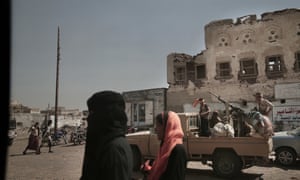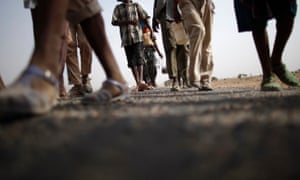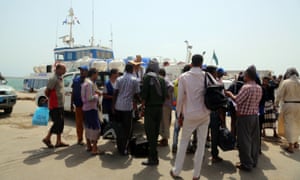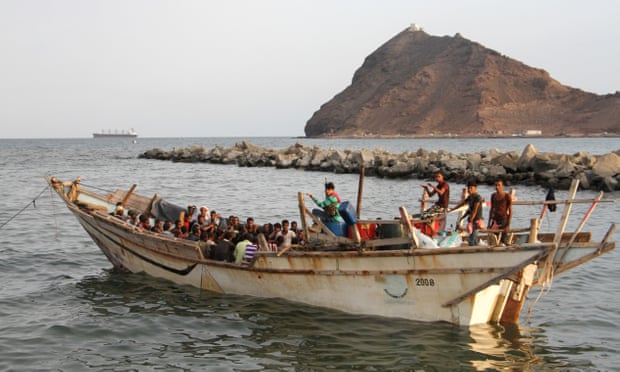Drownings, disease and abuse fail to deter on route supposed to be safer option from east Africa
When the boat’s engines stopped, the beatings began. The smugglers tried to keep order by hitting the panicking passengers with rifle butts and their fists. It was night, and the Yemeni coast was invisible, though only a few hundred metres away across a choppy sea.
“The boat floated for a while, then overturned. I had never seen the sea before so I did not know how to swim. I prayed to God to save me. I was lucky,” said Sahra Adam, a 31-year-old from a small town in southern Somalia.
Thirty people are thought to have died in the previously unreported sinking off the coast of Yemen in August, many of them children.
The tragedy was among dozens that have occurred in recent months on one of the busiest clandestine migration routes in the world. It leads from poor and unstable countries in eastern Africa to Yemen, then on to wealthy Gulf states and sometimes Europe.
More than 100,000 people are expected to travel along at least part of this “eastern route” by the end of this year, as many as are anticipated to crossthe Mediterranean, according to latest statistics. It is supposed to be the safer option, avoiding a long desert journey, but is lethal enough.
Local humanitarian officials and security experts say it is impossible to know how many have been killed in incidents similar to that described by Adam. Estimates range from 150 a year to 10 times as many.
“There can be up to five or 10 boats leaving every day, sometimes many more … Even if there is just one migrant dying every day that’s too many, but there are likely to be many more deaths that are unaccounted for,” said Danielle Botti, a Nairobi-based analyst with the Mixed Migration Centre.
In early June, coastguards recorded the death of 46 people after their boat capsized near Bosaso, Somalia. Sixteen others were missing.
In January people smugglers fired automatic weapons at migrants and refugees off Aden to force them to jump into heavy seas. In another incident in August last year, smugglers made 120 people including children jump overboard less than a mile off the Yemeni coast. Dozens died on both occasions.

Those who reach Yemen, a country torn apart by a civil war, cholera and famine, face systematic abuse at the hands of local security forces while being held in appalling conditions in makeshift detention camps. As the proxy conflict has intensified, historical local traditions of hospitality towards immigrants from east Africa have weakened and growing chaos has allowed traffickers and people smugglers to act with impunity, regional observers say.
Though the final destination of many is Saudi Arabia or other wealthy Gulf states, Adam is one of a small but growing number aiming to reach Europe. She eventually reached Aden and now plans to make another dangerous crossing, this time west to Port Sudan before travelling north along the coast to Egypt and the Mediterranean. Even with the risky double crossing, the route is considered safer than heading directly across the desert from Khartoum.
“Thanks be to God, I am not scared. I will keep trying. I am still hopeful that I’ll make it eventually,” she told the Guardian.
Most of those making the journey are Ethiopian, though some are Somalis and Eritreans. A recent UN survey found almost 85% said they were travelling to escape limited economic opportunities at home or poverty. Only a minority cited armed conflict or human rights violations. Most are young men. Of the many children, about a quarter are unaccompanied.

Adam, once a keen basketball player, travelled because her home town was in an area controlled by al-Shabaab, the al-Qaida-linked Islamist group. “Life was unbearable,” she said.
People smugglers only charge a few hundred dollars for the trip to Yemen, a fraction of the cost demanded for the more direct, and more lethal, route to Europe through Sudan to Libya.
Salad Nur Hassan, a 23-year-old Arabic teacher at a religious school, nearly died as he tried to reach Port Sudan from Yemen in January. Dozens drowned when the boat he was on capsized. Among the dead was his 19-year-old brother.
“A hundred of us were put into five-metre fishing boat. At midnight in the middle of the sea, the traffickers started to beat us saying that we were too heavy and the boat was unbalanced. Then the engine stopped and we started drifting,” Nur Hassan said. There were no life jackets. They said you have to swim … go swim … swim. They were armed and gave us no other option. We jumped into the sea. They started shooting us. I could hear my brother screaming for help. I could not help him.”
New “pay on arrival” schemes are encouraging travel on some migration routes.
Yasin Muse Bindhe, a 42-year-old people smuggler based in Bosaso in the semi-autonomous Puntland region, said people now asked for guarantees of safe passage.
“Theeir families want to make sure their person reaches their destination safely so we agree they can travel now and pay later. When they reach Yemen, a trafficker arranges a phone call with their families who then release the money to us. It is simple and this brought some sort of trust to our services.”
Bindhe denied his network had ever forced people into the sea and blamed Yemeni smugglers for the deaths in recent years.

“Sometimes when those bad guys see the anti-piracy forces [patrols of international warships] in the gulf of Aden, they start to force migrants to drown to escape from being caught. That is when the problem of shooting starts,” he said.
People travel in the opposite direction too. Tens of thousands of have fled Yemen for Somalia and Djibouti. Others have made repeated crossings of the gulf of Aden in search of work, safety, or both.
In Mogadishu last week, Ibrahim Husein Mohamed, 27, was making final preparations to travel to Europe. A previous attempt via Sudan and Libya last year ended in captivity in Tripoli. Mohamed, a qualified accountant, was sold by people smugglers to an armed militia who forced him to work unpaid in a garage for many months before he was rescued by the UN and local NGOs. He is undeterred.
“I have no future here. How can I stay here without knowing what my future will be like? I can’t get a job. I can be killed easily,” he said.
“I’m not afraid to die in the sea while I don’t have any right to life in my country. My aim is to reach and live in Europe whatever it takes.”
By Jason Burke Africa Correspondent and Abdalle Ahmed Mumin in Mogadishu
![]()






























